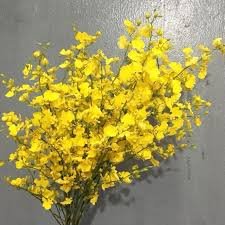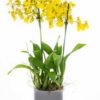**What is Dendrobium Orchid? Its Origins and History**

Dendrobium orchids, commonly known as “Vu Nu” orchids in Vietnam, are among the most diverse and widely distributed genera in the orchid family, Orchidaceae. They comprise over 1,800 species and numerous hybrids, captivating orchid enthusiasts and gardeners around the world. The beauty of Dendrobium orchids lies not only in their stunning floral displays but also in their rich history and cultural significance.
### Origins of Dendrobium Orchids
Dendrobium orchids are predominantly found in tropical and subtropical regions, particularly in Southeast Asia, Australia, and the Pacific Islands. The genus Dendrobium was first described by the Swedish botanist Olof Swartz in 1799. The name “Dendrobium” is derived from the Greek words “dendron,” meaning tree, and “bios,” meaning life, which refers to the tree-dwelling habit of many species within this genus.
The Dendrobium species have adapted to various habitats, ranging from rainforests to mountainous regions. Their adaptability allows them to thrive in a wide range of conditions, making them a favorite among collectors and horticulturists. Some notable species include Dendrobium nobile, Dendrobium kingianum, and Dendrobium phalaenopsis.
### Historical Significance
Dendrobium orchids have a long and fascinating history that intertwines with human culture. In many Asian cultures, particularly in China and Vietnam, these orchids are symbols of beauty, elegance, and refinement. They have been cultivated for centuries, with records indicating their use in traditional medicine and as ornamental plants in royal gardens.
In ancient China, Dendrobium orchids were prized for their aesthetic qualities and believed to possess healing properties. Traditional Chinese medicine often used them to treat various ailments, including respiratory issues and digestive problems. The orchid’s natural beauty and delicate fragrance made it a popular choice for aristocrats and scholars, who would often cultivate them in their gardens as a reflection of their status and taste.
In Vietnam, the Dendrobium orchid, known as “Vu Nu,” has gained significant cultural importance. It is often associated with purity and spirituality, frequently appearing in religious ceremonies and festivals. The flower’s elegant appearance and diverse colors make it a symbol of prosperity and happiness, often used in traditional Vietnamese floral arrangements during significant celebrations such as Tet (the Lunar New Year).
### Cultivation and Care
Dendrobium orchids are relatively easy to cultivate, making them suitable for both beginners and experienced growers. They thrive in well-draining potting media and require bright, indirect sunlight to flourish. Here are some essential care tips for cultivating Dendrobium orchids:
1. **Light Requirements:** Dendrobium orchids prefer bright, indirect sunlight. They can tolerate some direct sunlight but should be protected from harsh afternoon sun, which can scorch their leaves.
2. **Watering:** These orchids require consistent moisture but are susceptible to root rot if overwatered. Water them thoroughly when the potting media feels dry to the touch. During the growing season, typically in spring and summer, they may need more frequent watering.
3. **Humidity:** Dendrobium orchids thrive in high humidity levels. Maintaining humidity around 50-70% is ideal. In drier environments, consider using a humidity tray or a humidifier to create a suitable atmosphere for your orchids.
4. **Fertilization:** Use a balanced, water-soluble orchid fertilizer every two weeks during the growing season. Reduce fertilization in the fall and winter when the plants enter a resting period.
5. **Repotting:** Dendrobium orchids benefit from repotting every one to two years. This practice refreshes the potting media and encourages healthy root growth. Choose a pot that allows for adequate drainage, and be gentle when handling the roots during repotting.
6. **Pest Management:** Keep an eye out for common pests such as aphids, mealybugs, and spider mites. Regularly inspect your plants and treat any infestations promptly using insecticidal soap or neem oil.
### The Role of Dendrobium Orchids in Culture
Throughout history, Dendrobium orchids have played a significant role in various cultural practices. In many Asian societies, these orchids are more than just ornamental plants; they embody deep symbolism and spiritual significance. For instance, in Chinese culture, the Dendrobium orchid represents beauty, elegance, and nobility. It is often featured in traditional art, poetry, and literature, symbolizing the refined qualities of the cultured individual.
In Vietnamese culture, the “Vu Nu” orchid is associated with love and affection. It is commonly given as a gift during special occasions, including weddings and anniversaries, to express sentiments of love and appreciation. The delicate flowers and pleasant fragrance make them a popular choice for floral arrangements used in ceremonies and rituals.
Moreover, Dendrobium orchids have found their way into various festivals and celebrations across Asia. For example, in Vietnam, the Tet festival often features these beautiful flowers as part of the holiday decorations. Their presence during this significant time emphasizes their role in promoting happiness, prosperity, and good fortune for the upcoming year.
### Modern Cultivation and Hybridization
In recent years, the popularity of Dendrobium orchids has led to increased cultivation efforts and hybridization. Orchid enthusiasts and botanists have worked tirelessly to develop new hybrids that exhibit unique colors, patterns, and growth habits. This passion for hybridization has resulted in stunning varieties that are now available to collectors and gardeners.
One of the most well-known hybrids is the Dendrobium phalaenopsis, a cross between Dendrobium species that produces flowers resembling those of the Phalaenopsis orchid. This hybrid has gained immense popularity for its striking appearance and ease of care, making it a favorite choice among orchid lovers.
The demand for Dendrobium orchids has also led to advancements in cultivation techniques. Growers now utilize modern technologies such as tissue culture to propagate orchids efficiently and ensure the availability of high-quality plants. This method not only allows for the mass production of desirable hybrids but also contributes to the conservation of endangered Dendrobium species.
### Conservation Efforts
As with many orchid species, the survival of Dendrobium orchids in their natural habitats is threatened by deforestation, habitat destruction, and illegal collection. To combat these challenges, various conservation initiatives have been established to protect these beautiful plants and their ecosystems.
Organizations and botanical gardens worldwide are working together to conserve Dendrobium orchids through research, education, and habitat restoration efforts. These initiatives aim to raise awareness about the importance of preserving orchid diversity and the need for sustainable cultivation practices.
### Conclusion
Dendrobium orchids, with their stunning beauty and rich cultural history, hold a special place in the hearts of many. From their origins in tropical rainforests to their significance in various cultures, these orchids have captured the imagination of people around the globe. As we continue to cultivate and appreciate Dendrobium orchids, it is essential to promote conservation efforts to ensure their survival for future generations to enjoy. Whether as cherished ornamental plants or symbols of love and beauty, Dendrobium orchids will always be a beloved part of the floral world.

